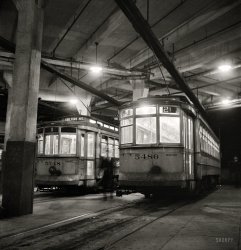
MAY CONTAIN NUTS

Search Shorpy
SHORPY ART

Framed or unframed, desk size to sofa size, printed by us in Arizona and Alabama since 2007. Explore now.
Join and Share
Ad-Free Shorpy
Shorpy is funded by you. Patreon contributors get an ad-free experience.
Learn more.

Recent comments
- Indiana Harbor Belt abides
- Freezing haze
- Corrections (for those who care)
- C&NW at Nelson
- Fallen Flags
- A dangerous job made worse
- Water Stop
- Passenger trains have right of way over freights?
- Coal
- Never ceases to amaze me.
- Still chuggin' (in model form)
- Great shot
- Westerly Breeze
- For the men, a trapeze
- Tickled
- Sense of loneliness ...
- 2 cents
- Charm City
- What an Outrage
- Brighton Park
- Catenary Supports
- Just a Little Before I was Born
- Afternoon normal
- The Flat Iron Cafe survives
- Aging in Place
- Raise your hand
- Good and Bad
- Oh, the 70's
- Nooooooi
- The aluminum tubing
Member Photos
The Shorpy
Print Emporium
Print Emporium
Search Shorpy
Search results -- 30 results per page
- Where I'm Coming From: 1943
- January 1943. "Freight train operations on the Chicago and North Western Railroad between Chicago and Clinton, Iowa." Somewhere in Illinois between Cortland and Malta, ... Posted by Dave - 03/24/2017 - 6:32pm -
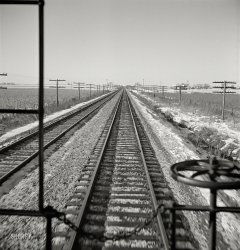
- "Yank" Cunningham and son: c. 1895
- Taken in Chicago in about 1895. John Dominic "Yank" Cunningham (shown here with his son ... neighborhood on West 111th Street in the Southwest Chicago at that time. He passed away in 1907. Yank was my great aunt Rose Ann ... restaurant, hotel he ran at 11th & Sacremento in the Chicago neighborhood of Mt Greenwood at the turn of the century. Please post ... Posted by wilso127 - 07/06/2012 - 8:01am -
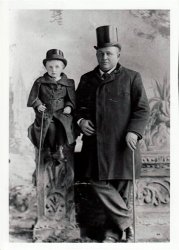
- City of Ottawa: 1907
- ... for war service in 1942, the India was brought down the Chicago River, Sanitary and Ship Canal, and the Illinois and Mississippi Rivers ... Posted by Dave - 01/22/2018 - 11:21pm -
![City of Ottawa: 1907 Cleveland circa 1907. "Steamer City of Ottawa entering Cuyahoga Creek." 8x10 inch dry plate glass negative, Detroit Publishing Company. View full size.
What is supporting that bridge?Was this photo somehow manipulated or am I just not seeing the bridge/ferry landing properly? The shadows do not look correct, nor does the water beneath it. Is the dark pile which is barely visible made of steel, and all that is bearing the weight?
[It's a swing bridge in the open position. -tterrace]
Thanks Dave...makes perfect sense now! I hadn't considered that it was pointing 90 degrees from its normal orientation :-) (even though I have a defunct center pivot one close by)
The Name GameCity of Ottawa had a pretty long life on the lakes, a nearly went further. Christened the INDIA in 1871, she joined sister ships in service known as CHINA and the JAPAN. From the annals of the Toronto Maritime Society, these were no run of the mill steamers plying the Great Lakes.
"...The passenger cabin of each was a veritable palace compared to other ships then operating. The staterooms opened off a long open passageway in which the dining tables were set at mealtimes. At the forward end of the cabin was the men's smoking room, while at the after end of the passenger area the cabin opened out into a spacious and luxuriously appointed ladies' cabin, complete with grand piano. The woodwork up to the level of the clerestory was varnished, while the deckhead was painted white. Woodcarvings were in evidence everywhere. The entire cabin was fitted with carpeting and an elegant companionway led down to the main deck where the purser's office was located. As usual for the period, bathroom facilities were not provided in the staterooms but each room did boast "running water" in that reservoirs mounted over the sinks were filled daily by the stewardesses and after that gravity did the rest. The galley was located on the main deck and the food (of excellent repute) was brought to the cabin by means of a primitive lift."
Ironically, while she went by City of Ottawa renaming for most of her sailing days, the ship started as INDIA and ended that way as well, while being refitted for saltwater use during WWII. She was sent down the Mississippi River to New Orleans but deemed too old and unfit, was eventually laid up along Lake Ponchartrain, where it's believed she meet her end to scrappers in 1945.
Launched on June 20, 1871 at Buffalofor the Atlantic, Duluth & Pacific Company by Gibson & Craig and the King Iron Works, the India was the first of a trio of state-of-the-art iron passenger and freight vessels running between Buffalo and Duluth, the others the China and Japan. Beginning the next year and for the next decade it ran for the Lake Superior Transit Company, allied with a pool of railroad-related steamship companies and after that with the Anchor Line, part of the Pennsylvania Rail Road. Sold in 1906 to the Montreal & Lake Erie Steamship Company, reflagged Canadian, repowered, and renamed the City of Ottawa, the vessel operated as the firm's name implies. Its passenger accommodations were removed in 1913 when Canada Steamship Lines Ltd. acquired the vessel and placed it in the package freight trade between Hamilton and Montreal. Laid up in 1926, the City of Ottawa was sold back into American registry briefly in 1928 and renamed India, and the next year back into Canadian registry for the Algoma Central Railway Company and renamed Sault Ste. Marie, running between Fort William and Toronto. In 1930 it again entered American registry and reverted again to the name India, cut down to a coal barge. Requisitioned by the Maritime Commission for war service in 1942, the India was brought down the Chicago River, Sanitary and Ship Canal, and the Illinois and Mississippi Rivers for a conversion that never occurred. The India was dismantled on the shore of Lake Pontchartrain in 1945.
The William L. Scott was built at Buffalo in 1890 by the Union Dry Dock Company for that city's Hand & Johnson Tug Line. It was abandoned and dismantled in 1915, probably at Erie, Pennsylvania.
Swing bridge?Never was a real fan of bridges that move. Really like them sitting still and anchored.
Getting A LiftFor fans and non-fans of moving bridges, the current edition at or near that same spot is a rather impressive rail lift bridge, rather than swing version. Everything's up to date in Cleveland.
Tugging at your heartThe tug WILLIAM L. SCOTT, built in 1890, was steam powered and of wood construction, weighing 54 gross tons, with dimensions of 67.9 x 17.4 x 10 feet. It was dismantled in 1915 at Union Dry Dock, Buffalo Shipbuilding.
I suspect the boat may have been named for Pennsylvania congressman William Lawrence Scott (1828-1891).
(The Gallery, Boats & Bridges, DPC)](https://www.shorpy.com/files/images/SHORPY-4a25406a.thumbnail.jpg)
- Bankers' Row: 1910
- ... Jacksonville in this period, in something similar to the "Chicago School" style. His most graceful Jacksonville skyscraper, the even ... Posted by Dave - 08/17/2015 - 4:35pm -
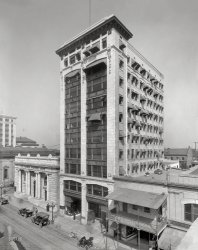
- Liberty Avenue: 1914
- ... see two buildings designed by D. H. Burnham & Co. of Chicago in this view: 1) Union Station (1898-1903), the hazy square block at ... Posted by Dave - 08/15/2012 - 4:37pm -
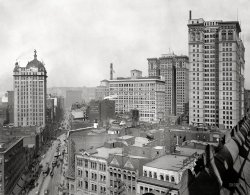
- Milwaukee of Buffalo: 1910
- ... freighters.
This Milwaukee was built in 1902 by the Chicago Ship Building Company.
(The Gallery, Boats & Bridges, Buffalo NY, ... Posted by Dave - 11/09/2017 - 1:40pm -
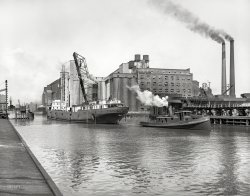
- Young Models: c. 1900
- ... of the other. The photograph is by the Tonnesen Sisters of Chicago, c. 1900. The Tonnesen Sisters ran one of the country's first photo ... Posted by Ken - 12/04/2007 - 8:06am -
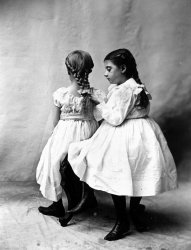
- Grant Park: 1911
- Chicago circa 1911. "Grant Park, south from Art Institute." 8x10 inch dry plate ... the station at the Art Institute is in the Shorpy photo Chicago: 1901.
Another look at the Art Institute from the south is this ... is the same view from June of 2017.
(The Gallery, Chicago, DPC) ... Posted by Dave - 08/07/2014 - 5:17pm -
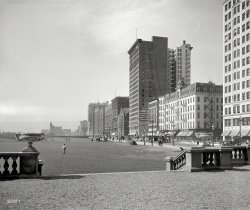
- Hi-Fi 1954
- ... and I remember listening to WLS (I think that was it) in Chicago at night. I used that receiver right up till I went in the army in 73. ... Posted by tterrace - 09/22/2011 - 7:20pm -
![Hi-Fi 1954 My brother's do-it-yourself hi-fi. From Top: tweeter, woofer, Webcor portable phonograph, Heathkit amplifier. One of his high school buddies assembled the Heathkit for him. He took this in the upstairs bedroom we shared until a year or so later. That's my bed on the right. Check out our cool wallpaper. View full size.
HeathkitI can't begin to count how many Heathkits and Knight-Kits I built over the years. It's another lost art -- no one builds kits anymore. Electronic parts are so tiny these days you can barely see them, much less handle them. It's all done by machines.
Heathkit Memories (Egads)My dad built a Heathkit television, he started in the mid/late 70's. I'm pretty sure he never really finished it. I don't wish to knock Heathkit because it never really worked, but that could be because of Dad's skills.
Iit did work for a while, but not for long. At one point Dad decided it needed a remote control, so he built one.
Using an incredibly long highway of that rainbow wire strip, attached to a black plastic box with a metal face. It had two buttons, using that labeling tape - ON and the other OFF.
When I was 10 I thought it was pretty spiffy, really.
HeathkitMy father and I built 4 Heathkit televisions and numerous other kits. With a kit that large it took a bit of determination to troubleshoot a problem but Heathkit provided good tech support and if necessary would repair/build your kit if you had problems.
Shortwave radioFor one Christmas in the early 60's my folks got me a Heathkit shortwave receiver kit. This was back when FM was still unheard of I think. Dad and I spent about an hour or two each night for what seemed forever building it. We had built an oscilloscope prior to that. I don't ever recall what we used the scope for though it stayed with the family for decades and finally found a dumpster just after Dad's passing in 2000. The radio was fantastic though. We strung a 50 foot antenna across the back yard and I remember listening to WLS (I think that was it) in Chicago at night. I used that receiver right up till I went in the army in 73.
[Wouldn't that be AM, not shortwave? As for FM broadcasting, there were hundreds of FM stations by the early 1950s. - Dave]
(ShorpyBlog, Technology, Member Gallery, tterrapix)](https://www.shorpy.com/files/images/hifi.thumbnail.jpg)
- Goggle Glass: 1942
- December 1942. "Chicago, Illinois. Workman grinding out a small part at the Chicago & North Western repair shops." Medium-format negative by Jack ... Posted by Dave - 08/30/2014 - 11:58am -
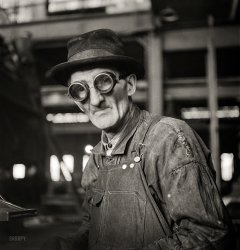
- The Sherman: 1899
- ...
[Booze. - Dave]
From the Encyclopedia of Chicago:
A second type of drinking place evolved from grocers and ... Posted by Dave - 09/16/2018 - 5:38pm -
![The Sherman: 1899 Mount Clemens, Michigan, circa 1899. "Sherman House." And its Sample Room. 8x10 inch glass negative, Detroit Photographic Company. View full size.
119 Years LaterNorthwest corner of Cass and Gratiot where the Sherman House used to stand. Now a Macomb County office building housing, among other things, the offices of the Friend of the Court.
The Object across the streetWith the Round Globe and appears it would be colorful. Is It a fancy Barber Pole?
Streetcar tracks and---dirt roads, I didn't know they coexisted.
Stone TabletsThe stone tablets standing on edge in the gutters were to prevent the utility poles from being struck by wagon wheel hubs. Often you will also see many spirally wound wraps of steel wire around pole bases, or steel sheet, to similarly protect poles from damage. It must have been a real problem.
Obsolete CommunicationsTwo types of obsolete communication in this picture struck me. The paperboy and Western Union bike messengers.
What the heck would they be sampling?
[Booze. - Dave]
From the Encyclopedia of Chicago:
A second type of drinking place evolved from grocers and provisioners who began to sell hard liquor in wholesale quantities. At first, their sample rooms were places where customers could taste-test the stock; long afterward, "sample room" became simply another name for saloon.
(The Gallery, Bicycles, DPC, Streetcars)](https://www.shorpy.com/files/images/SHORPY-4a03997a.thumbnail.jpg)
- Spaghetti Girls: 1921
- ... with timbers from the 1893 World's Columbian Exposition in Chicago. In its early years Foulds was a major employer in Libertyville, ... Posted by Dave - 09/03/2012 - 11:54am -
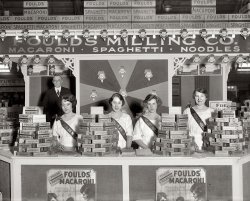
- Pacific Mutual: 1909
- ... analogous to the glazed "skin and bones" designs of the Chicago School architects of the turn of the century. I think the design is ... Posted by Dave - 05/06/2020 - 2:23pm -
![Pacific Mutual: 1909 Los Angeles circa 1909. "Pacific Mutual Life & Accident Co. building, Sixth and Olive streets." 8x10 inch dry plate glass negative, Detroit Publishing Company. View full size.
Egads!What a monstrosity! Like someone took parts from a classical architecture guide and threw them together with no concept of how they were supposed to work in proportion. Long gone, thank goodness.
[Not long gone, just remodeled with a Moderne makeover in 1936. -- Dave]
Not so bad after allI disagree with timotheus; the architect of this Beaux-Arts building knew how to handle the Classical orders quite well. The colossal Corinthian pilasters and columns are correct in every detail; the columns taper towards the top, as they should, while the pilasters are ramrod straight. The impressive pileup at the corner is worthy to stand comparison with the work of Michelangelo at St. Peter's or that of Ange-Jacques Gabriel at the Petit Trianon. The entablature is correctly detailed and proportioned, although the treatment of the frieze (the horizontal band with the small horizontally oriented windows) is somewhat unorthodox precisely because of those same windows. But it is certainly not beyond the pale. True, the whole thing might look better without the attic story on top, but still ... Despite the domineering presence of the large-scale Classical elements, the use of vast amounts of window wall filling out every inch of space between the columns and pilasters makes this building analogous to the glazed "skin and bones" designs of the Chicago School architects of the turn of the century. I think the design is distinctly better than the pallid Art Deco shroud that replaced this exuberant facade in the 1930s.
Beautyis in the eye of the beholder.....and I really like the 1909 version a lot more!
They must have had VERY spacious offices back then with such large windows,
did the Detroit Publishing Company do indoor photos a la Gottscho-Schleisner, too??
Deco-ratingHere's the remodeling underway...
from https://tessa.lapl.org/cdm/ref/collection/photos/id/116534
(The Gallery, DPC, Los Angeles)](https://www.shorpy.com/files/images/SHORPY-4a25756a.thumbnail.jpg)
- Harbor Springs: 1906
- ... Traverse Bay area in 1903. Lincoln Park Boat Line of Chicago acquired her about 1911, and she met her end on there on Morgan Shoal, ... Posted by Dave - 09/05/2014 - 12:13pm -

- Lunch With Elibia: 1943
- April 1943. Clinton, Iowa. Chicago & North Western Railroad "Mrs. Elibia Siematter, employed as a ... Posted by Dave - 08/30/2012 - 3:31pm -
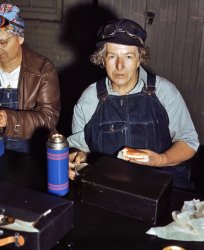
- Grain Train: 1939
- ... Belt Route engine. No.475 is an 0-6-0 belonging to the Chicago Great Western Railway. It was built by Baldwin in 1916, and scrapped in ... Posted by Dave - 12/22/2017 - 10:52am -
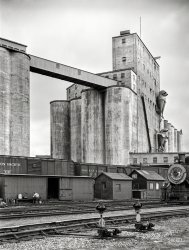
- Guys and Dolls: 1955
- ... the crap game scene was B.S. Pully, playing Big Julie, the Chicago Mobster, announcing to the players that they will use his dice. The ... Posted by Dave - 05/19/2014 - 1:57pm -
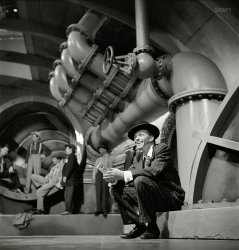
- The Ruby Troupers: 1953
- ... of the women's jail) in the original Broadway cast of "Chicago" (1975).
(Kodachromes, Dance, John Vachon, LOOK) ... Posted by Dave - 01/20/2014 - 4:19pm -
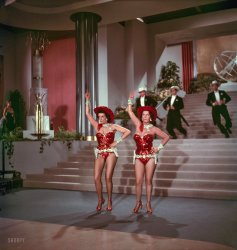
- Fun Between Times: 1909
- ... young.
You never come back.
-- Carl Sandburg, "The Chicago Poems"
Fun between times I think the seven boys in the picture ... Posted by Dave - 07/27/2008 - 9:43pm -
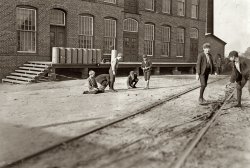
- Tower B: 1943
- May 1943. Melrose Park, Ill. Chicago & North Western towerman R.W. Mayberry of Elmhurst at the Proviso ... Posted by Dave - 08/30/2012 - 2:00pm -
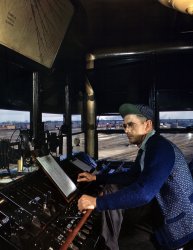
- Roy Nelin: 1942
- ... Nelin, a box packer in the Proviso Yard roundhouse of the Chicago & North Western R.R. View full size. 4x5 Kodachrome ... Posted by Dave - 08/30/2012 - 2:02pm -
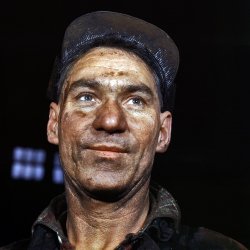
- Handsome Hoya: 1925
- ... Claude Grigsby, "a well-built, iron-muscled lad from Chicago," according to the Washington Post. National Photo Company glass ... Posted by Dave - 08/27/2012 - 12:10pm -
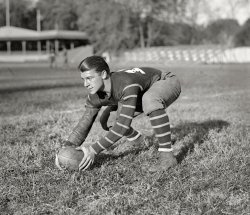
- Fast Food: 1943
- ... the caboose on the Atchison, Topeka & Santa Fe between Chicago and Chillicothe." Medium-format negative by Jack Delano for the Office ... Posted by Dave - 02/07/2014 - 3:19pm -
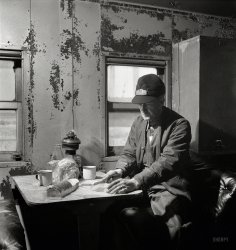
- Beach Style Parade: 1922
- ... the 1940s, she reappeared in various daily newspapers as "Chicago's Stone Woman," a reference to a disabling affliction that caused some ... Posted by Dave - 07/06/2018 - 10:20pm -
![Beach Style Parade: 1922 June 17, 1922. Washington, D.C. "Washington Advertising Club bathing beauty contest at Tidal Basin." Harris & Ewing Collection glass negative. View full size.
"Quintet of beauties wore the models of Lansburg & Brother, which captured first prize in the store competition." Caboose of the quintet is Miss Iola Swinnerton, First Lady of Shorpy, who took second in the individual costume contest. Read all about it here.
Miss IolaIt's nice to see her again, even if only a glance.
Laurels to Former Follies Girl
Washington Post, June 18, 1922.
CROWN ANNA NIEBEL
BEACH STYLE QUEEN
Judges at Tidal Basin Contest
Award Costume Laurels to
Former Follies Girl
5,000 WATCH AS 45 PARADE
Simple Attire Wins -- Miss Swinnerton Second -- Lansburgh's Captures Store Prize
Five thousand Washington lovers of the aesthetic, artistic and beautiful -- and, incidentally, of aquatic pastimes -- crowded the Tidal Basin bathing beach yesterday afternoon to witness the annual bathing costume style show, staged under the auspices of the Washington Advertising club. Bathing costumes entered by 11 local stores were exhibited by 45 selected models.
Miss Anna Niebel, former Follies girl, who lives at 1370 Harvard street northwest, won first prize by unanimous vote of the judges. Her prize-winning costume was one of the most simple exhibited, indicating that the element of practical usefulness was taken into consideration by the judges in making the award. She represented the Sportmart [seen here, here and here].
Former Winner Takes Prize.
Miss Iola Swinnerton, 3125 Mount Pleasant street, winner of a former beauty contest at the basin, was the second choice of the judges. Her suit was one of the five entered by Lansburgh & Bros., the firm to which was awarded the cup for the best composite store exhibit.
L.E. Rubel, chairman of the Advertising club committee, in charge of the contest, presented the cups to the winners.
The entries ranged from the extreme simplicity of the one-piece type of suit with the abbreviated skirt to more elaborate creations with multitudinous frills and ruffles. A knitted toque to match the wearer's suit was one of the innovations in bathing headgear that attracted attention.
Not So Much Scantiness.
Most of the suits were more extensive, so far as the amount of material used was concerned, than those exhibited in former years. A rubber suit of green and white cut on extremely loose lines set the pace for originality.
Weather conditions were ideal for the show, although it had been announced that all suits entered were of the kind that could have been worn in the rain without damage.
Iola!As always, I only have eyes for Ms. Swinnerton. She is always lovely.
Iola's second 15 minutes of fameAfter the roaring twenties, Iola Swinnerton's trail goes cold for a while. But in the 1940s, she reappeared in various daily newspapers as "Chicago's Stone Woman," a reference to a disabling affliction that caused some of her muscle tissue to calcify, leaving her disabled. Her 1942 marriage to Theron V. Warren, described as an organist and shipyard worker, was also covered, including photos in various papers of her repeating her vows from her wheelchair. Other than an unsuccessful petition for certiorari to the U.S. Supreme Court filed on behalf of Theron V. Warren in 1958, and his death in 1975, I could find no other clues to their fate after 1947.
[According to our earlier research, Iola Taylor married Gerald Swinnerton in 1918; he deserted her in 1941. Evidently her affliction was too much for him to bear. - Dave]
(The Gallery, D.C., Harris + Ewing, Iola S., Swimming)](https://www.shorpy.com/files/images/SHORPY-42237a.thumbnail.jpg)
- Northern Swing: 1938
- ... Museum A building from a similar housing project in Chicago, Jane Addams Homes, also built in 1938, is being turned into the ... Posted by Dave - 08/07/2020 - 7:04pm -
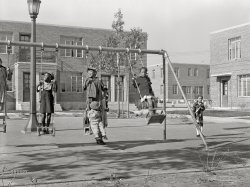
- Headline News: 1925
- ... 29, 1925, involving submarine S-48, that matches the Chicago newspaper's headline. Traveling up the New England coast from New ... Posted by Dave - 09/05/2012 - 9:47am -
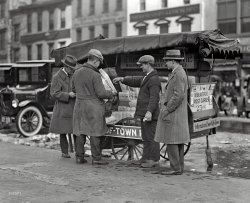
- Snow Belt Special: 1943
- ... operations on the Indiana Harbor Belt railroad between Chicago and Hammond, Indiana. The train pulls out of the Chicago & North Western yard." Photo by Jack Delano, Office of War ... Posted by Dave - 03/17/2015 - 9:39am -
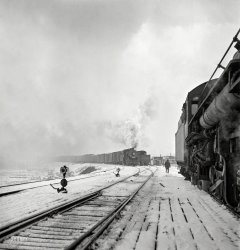
- Current Events: 1942
- ... Alabama. On April 17, 1972 he married Donna Growney in Chicago and she preceded him in death on November 16, 1994.
Survivors ... Posted by Dave - 07/01/2017 - 12:49am -
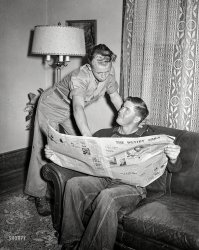
- Man of Steel: 1938
- ... Day to commemorate the 1886 Haymarket affair in Chicago! But if I understand things correctly, it was exactly that connection ... Posted by Dave - 09/07/2020 - 11:16am -
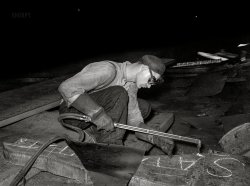
- Park Terminal: 1943
- ... Illinois Railway Museum, Union, Il, about 50 miles NW of Chicago. It's the largest railway museum in the US and, April through November, ... Posted by Dave - 11/01/2013 - 8:47am -
